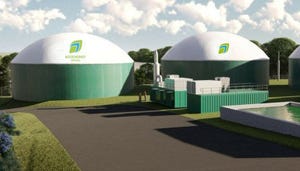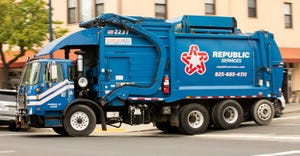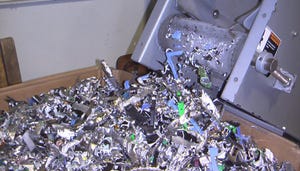How HydroBlox Tackles Hard-to-Recycle Plastics and Stormwater Problems
HydroBlox Technologies makes novel stormwater drainage products from 100% recycled plastics, and the hardest of them to work with—types #3-7. Ed Grieser, CEO HydroBlox, says his products are cheaper, easier to install, and longer-lasting than traditional French drain systems.

HydroBlox Technologies makes novel stormwater drainage products from 100% recycled plastics, and the hardest of them to work with — types #3-7.
Ed Grieser, CEO HydroBlox, says his products are cheaper, easier to install, and longer-lasting than traditional French drain systems.
He describes his brainchild as boards made of thousands of “noodles” of plastic, pressed together. They’re buried underground to suck up high volumes of accumulating water and redirect it to aquifers or other desired locations. His flagship product, HydroPlanks, moves rainfall along at 14 gallons a minute, while filtering out fines.
The systems lay under stretches of the Appalachian trail, highways, sports fields, and railroad tracks. They manage water runoff on green roofs, at construction sites, in parking lots, and residential yards. And they help control erosion on landfill slopes, hills that tower over oil and gas pipelines, and other infrastructure.
While lightweight, the plastic planks have compressive strength twice that of manhole covers that endure extreme loading daily, so the product is ideal for heavy-duty, civil applications Grieser says.
“It’s because of the way we put the boards together. When you compress them, they become stronger. They bind together and stay together,” he says.
Some end users are departments of transportation, utilities, and landscapers. Among feedstock suppliers are businesses who themselves are working on recycling solutions for the most complex polymers; they turn to HydroBlox when they don’t have a good answer. Some names you’ll recognize are Cyclyx and Ridwell, Braskem, Dow, and Reynolds. A few other industry knowns, including in waste management and a manufacturing giant that uses waste film, defer to HydroBlox for what they find too contaminated or otherwise too problematic to work with; they did not want to be named.
Grieser fields inquiries from businesses and governments as far away as Canada and even Australia. They want to know if it would make sense to transport their plastic waste across their borders to one of the Pennsylvania-based company’s plants. Typically, he can tell them they would come out ahead.
Waste haulers pay about three to six cents a pound to leave off their plastic loads, which is proving cheaper than landfilling. A third-party life cycle analysis shows environmental payoffs too, concluding, among findings, that freighting the material over 5,000 miles would still generate less global warming potential than landfilling.
Grieser’s biggest problem is trying to keep up with demand from his 126,000-square-foot plant in Meadville, Pennsylvania and three smaller facilities along the East Coast.
The total six lines run at full capacity, each processing about 6,000 pounds of material an hour. HydroBlox has sold out for the past five years. Now the plan is to launch a fourth site on the West Coast.
The simple systems are fast and easy to install. Grieser points to a recent project at a Hilton Head, South Carolina golf course where workers laid 424 feet of boards in four hours. He says covering as much ground with a French drain system would take days, requiring digging deep trenches; hauling and installing pipes, aggregate, and geotextiles.
The product is generally about one-third the cost of piping and aggregate infrastructure.
“But the real value is that regular drains fail within seven years, and we are at year 15 and never had a failure. So, you will spend less for what works longer,” Grieser says.
HydroBlox distributor Andy Amrhein buys tractor trailer loads of the plastic planks and sells them around the country under his three businesses: a retail hardware store, a commercial supply business, and an equipment rental company.
He met Grieser at a trade show and was taken aback to learn what the boards were made of. Over years of looking out for what’s new, better, and sustainable he’d talked to recyclers that worked with plastics #1 and 2 but tossed whatever other resins landed in their streams.
“I liked that the boards are made of 100% recycled plastic and that Ed takes all of them. But I also liked that homeowners would be able to take care of their swampy backyards without spending tens of thousands of dollars on French drain systems that fail within several years.
“It’s amazing in what it does; how it works; and how permanent it is. And it’s a bonus that it’s a recycled plastic,” Amrhein says.
Grieser’s beginning was shaky.
“At first, I was thrown out of every bank, venture capital company, and private equity group east of the Mississippi. They didn’t want to hear me out.”
All he had was a protype, with no revenue to show.
“I told [investors] we will get paid to take feedstock and this will go under roads and highways, and I lost them.”
Engineers initially turned a deaf ear because they thought their piping drainage systems were good enough, plus there’s little risk taking in engineering new products.
In those early days he had a hard time getting ahold of feedstock that he’s up to his ears in today.
“I’d take my truck to recycling centers and beg operators to sell me a gaylord of plastic. We couldn’t afford to buy truckloads, and they wanted to move volume.”
Meeting Amrhein at that trade show was a turning point.
“We showed him how to do installations and he beat the bushes with local municipalities and homeowners,” Grieser recalls.
Then an intrigued distributor on the West Coast brought the new innovation to other box stores, actually launching a contracting company to do installs and to build the market in that region.
Hefty, in the Reynolds portfolio, commissioned a third-party life cycle analysis of HydroBlox. The brand’s interest was in seeing if and what the company could lend to outcomes of its Hefty ReNew program, which collects waste polyethylene, polypropylene, and polystyrene made by any manufacturer.
“The HydroBlox process significantly reduced the environmental impact of our collected materials compared to sending them to the landfill. Additionally, HydroBlox provided an excellent opportunity to transform materials into a useful solution, reducing the need for materials like virgin PVC,” says Paul Benvenuti, director of Sales, Hefty ReNew Program and Sustainable Solutions.
As circularity becomes a resounding buzz word across industries, Grieser sees more work and opportunity ahead.
“One-hundred percent of the plastic we accept is turned into products. And we are seeing a growing number of our feedstock suppliers, in turn, using HydroBlox to solve their infrastructure and stormwater issues. As these suppliers become aware of the value of these products to address stormwater problems, we expect to see this trend increase, further advancing circularity.”
About the Author(s)
You May Also Like




